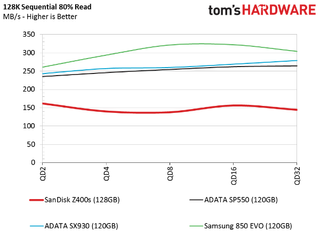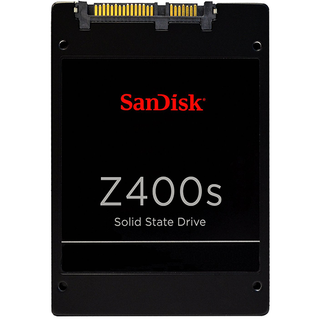SanDisk Z400s SSD Review
SanDisk has the exclusive on Silicon Motion's SM2246XT controller. What's more, we got our 128GB Z400s for just $.25/GB. But is this a true low-cost contender, or just a cheap SSD?
Why you can trust Tom's Hardware
Mixed Workload And Steady State
80 Percent Sequential Mixed Workload
Our mixed workload testing is described in detail here, and our steady state tests are described here.

In this test, we use sequential data mixed at 80 percent reads and 20 percent writes. This is right around the ratio characteristic of most home users. The drives are not in steady state, but they are conditioned prior to benchmarking. Mixing in those writes pulls the Z400s' performance down from what we saw when we were testing 100 percent reads on the previous page.
80 Percent Random Mixed Workload

The Z400s' random reads and writes fall below current standards. But when they're combined in a mixed workload, performance plummets. Still, the outcome we observe is better than what you'll get from a hard drive.
We can't ignoring pricing on this one. Just because an SSD is faster than a mechanical disk doesn't mean there isn't an even faster SSD selling in the same range.
Sequential Steady State



We often talk about the two steady state tests being specialty workloads that most users never encounter. Without a DRAM buffer, it's easier to beat the drive down to these lower-performing states, as the page table map is updating with each write to the drive. Those are random operations, by the way, which wear flash faster than sequential transfers.
Random Write Steady State


In steady state, the Z400s has difficulty writing a lot of data quickly. The Adata SP500 hugs the same low performance levels, but also has very pointed peaks where the buffer and over-provisioned flash area increase performance. I'm surprised SanDisk didn't also launch its Z400s with over-provisioned space to help deal with background activity.
Current page: Mixed Workload And Steady State
Prev Page Four-Corner Performance Testing Next Page Real-World Software PerformanceStay on the Cutting Edge
Join the experts who read Tom's Hardware for the inside track on enthusiast PC tech news — and have for over 25 years. We'll send breaking news and in-depth reviews of CPUs, GPUs, AI, maker hardware and more straight to your inbox.

EKWB reportedly plagued with financial disarray — many employees and suppliers were allegedly left unpaid for as long as four months

Adding ZIP file support to Windows 30 years ago almost got the creator of Task Manager fired

Carry-on server flexes up to 256 cores — 480TB NVMe and 4TB RAM join Ampere Altra CPU in new fly-away-kits
-
ZolaIII Would actually like to see the 240 GB model & dose it catches up at least reasonable with declared write speeds.Reply
Whole topic is a dead fish until we see first implementation next year that will use 3D XPoint RAM instead of DRAM for caching purposes. -
zodiacfml Nothing to see here except the OEMs who will probably save more by choosing this drive.Reply -
Duken4evr Newegg has Adata 128GB drives on sale for $38. Deal abound out there. OEMs may buy these for cheap so they can advertise their $400 laptop has an SSD, but the rest of us smart shoppers can score deals on better drives for our upgrade purposes.Reply -
Marcus Zettergren Part of the conclusion just doesn't make sense even though i agree the Evo is so much better.Reply
As a potential upgrade, the Z400s is a fairly poor prospect, largely because of its price. In terms of value, Samsung's 850 EVO just wrecks every other company's attempt to compete. With the 128GB Z400s at $45 and the 120GB 850 EVO going for $68, we have to recommend Samsung's offering.
Unless my maths are way off, which it very well could be, the EVO is 62% more/GB. For a gaming disk, the Z400 is just as good as the EVO, and i suspect for a thin ultrabook with a "U" cpu, the cpu will be the bottleneck long before an SSD would be a showstopper. -
photonboy Marcus Zettergren,Reply
Gaming performance (which mainly only affects load times) is but one use case scenario. The CPU isn't going to be the bottleneck either, though low-cost notebooks can be limited by the main chipset of the motherboard, though even then it wouldn't be a total bottleneck but could limit performance.
How the CPU, chipset, and different scenarios work isn't a simple calculation.
I think this is GREAT to have an offering like this. I know fast SSD's seem important to most people but they way my sister uses her PC she wouldn't know the difference. It would still boot up pretty quick and then she's mostly in an office environment.
It's a lot faster than an HDD at times, reasonably inexpensive, and won't take several seconds to come out of standby mode like an HDD. -
nekromobo ReplyIf we want to push solid-state storage into lower-end systems, the expensive DRAM has to go.
According to Anandtech this December 2015:
The average spot price of one 4Gb DDR4 memory chip rated to run at 2133MHz was $2.221 at press time, according to DRAMeXchange,
So for a DRAM in SSD thats 2.221$ well spend (Ok, maybe it increases cost 4$ but anyway...)
Make it DDR3 and youll save 50cents. -
CRamseyer There is a bit more to it than just the physical DRAM. The controller has to have provisions in place for it, the extra design in the PCB, other components to support the DRAM and so on. It all adds up when companies are fighting to find a way to shave off a few Dollars at a time.Reply -
photonboy Reply17193485 said:There is a bit more to it than just the physical DRAM. The controller has to have provisions in place for it, the extra design in the PCB, other components to support the DRAM and so on. It all adds up when companies are fighting to find a way to shave off a few Dollars at a time.
Exactly.
Let's do some more meaningful algebra which I'm making up of course but know to be quite possible:
1) Profit margin of laptop-> $10
2) Savings on SSD (total) vs faster SSD-> $5
Profit is DOUBLED!
Most people will just see that it's an SSD and the capacity on the entry or mid-tier devices this would be aimed for. Saving $5 can make a huge difference in profits since as said they're fighting over scraps a lot of the time.
Some mobile devices were actually just BREAKING EVEN due to the tight competition and price drops. -
uglyduckling81 Reply
1) Profit margin of laptop-> $10
2) Savings on SSD (total) vs faster SSD-> $5
Profit is DOUBLED!
Just tell me again how a $10 profit increased to a $15 profit is double?

